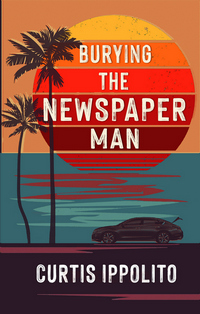 |
Burying The Newspaper ManeARC, 244 pg. Read: March 10-11, 2021 |

What’s Burying The Newspaper Man About?
I’m going to lean heavily on the Publisher’s Description here, because this is one of those books that I’m afraid to say anything about. “This is a book about a police officer who finds something that disturbs him. This officer used to be a child and things happened. Now he has to deal with his life.” Just doesn’t sound all that interesting, right?
Marcus Kemp is a beat cop in San Diego who has a knack for discovering stolen cars. The book opens with him discovering his fortieth of the year—a record-setting pace that should crush his previous record. It’s a fairly upbeat opening that should make anyone worried—in this car he discovers a dead body. Decades ago, when he was growing up in Texas, the man in the car trunk repeatedly sexually abused Marcus.
Marcus knows he should inform the detectives who come to the scene that he knows who the victim is, that there’s a tie between them—and that he can possibly point at a motive for the killing. But he doesn’t do that. Instead, he starts an off-the-books investigation of his own into finding the killer. Not to bring the killer to justice, but to help him avoid arrest.
He ends up lying to his lieutenant, abuses his office, breaks I don’t know how many laws (he loses count, too)—putting his career and his freedom at risk—for the opportunity to aid and abet this man’s killer.
A Matter of Focus
In a book that ostensibly is about a cop hunting a murderer, the novel isn’t all that interested in the killer. It’s primarily interested in one of the cops hunting for the killer. The emphasis is on both what happened to Marcus as a child and how he’s dealing with it in the shadow of his abuser’s killer. We get a long look at the events leading up to the abuse—Marcus’s already troubled home life, his friends, and then choices that put him in repeated contact with the abuser.
The other emphasis is what Marcus goes through after finding the body. In the intervening years, he’d stopped thinking about the abuse. But once he recognized the body, he can’t stop thinking about it. He begins to see how so many of his choices are made because of the abuse, what it’s done to the way he thinks, the way he acts, and his relationships now.
This isn’t to say that Marcus’s hunt for the killer is unimportant, but it’s of tertiary importance at best. Thanks to a lucky break or two—scratch that, thanks to Marcus taking advantage of a lucky break or two, it’s a fairly uncomplicated hunt. But that’s the only thing lacking complication in the novel. As Marcus isn’t officially investigating or looking for an arrest, he doesn’t have to adhere to a typical protocol (even the curtailed protocol we let fictional heroes get away with). It’s striking how little we learn about the killer throughout the novel. It’s not a typical choice, but it works really well in these circumstances.
So, what did I think about Burying The Newspaper Man?
This isn’t at all what I expected from the novel. It’s richer, it’s deeper, and better realized than I expected (whether or not that’s fair, it’s true). Yes, there’s a lot of psychological trauma and depictions of Marcus’ trying to cope—but there’s some great action, too.
Aside from that, there are some great descriptions of life in San Diego—you can feel the atmosphere around the beach, in Marcus’s neighborhood. Ippolito gave us enough local character to ground the action—and a little extra, too. There’s even a nice flashback to a San Diego Comic-Con to further establish the setting and show us a non-professional side of Marcus beyond the abuse survivor.
I fear Ippolito rushed through the denouement, it could’ve easily lasted 3-4x as long as it did while holding the audience’s attention. But that’s not the style of Burying the Newspaper Man. Ippolito isn’t about answering all our questions, he focuses on what he thinks is most important, and if you agree with him, all the better.
There are enough “atypical Crime Fiction” elements to this book to appeal to readers that don’t usually touch Crime Fiction. There are enough “typical Crime Fiction” elements to appeal to die-hard fans of the genre. It’s the former that adds depth to this novel that you’re not used to, but that serves to make this more emotionally satisfying, and possibly genre-expanding.
Whichever camp you fall into—Crime Fiction reader or not, I recommend this novel to you—ignore the genre and just enjoy something well done.

![]()

My thanks to Red Dog Press for the invitation to participate in this tour and the materials (including a copy of the novella) provided.




wittysarcasticbookclub
I don’t think I could handle the subject matter, but it definitely seems like a unique book.
HCNewton
You know, I meant to cover that. Rats. It happens, the reader knows it, but the novel doesn’t get into the details. Nothing at all graphic.
But yeah, I get where a lot of readers wouldn’t want to tackle it because of the subject matter.
wittysarcasticbookclub
I’m glad it wasn’t graphic. I think what people can handle just varies person to person. It seems like it makes for a really interesting personal crisis in the book, so to speak